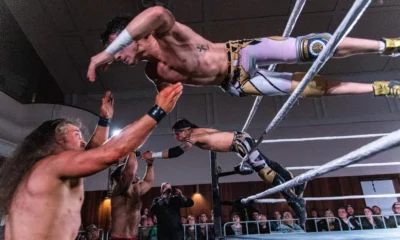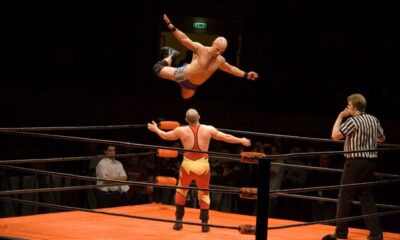
Wrestling has existed since ancient France, first appearing in cave paintings some 15,000 years ago. Ancient wrestlers were depicted in Babylonian and Egyptian artifacts using tactics that modern-day practitioners utilize in the sport. It is referenced in the famous poem Iliad.
Wrestling tactics include grappling, clinch combat, joint locks, throws and takedowns, and pins. It is the skill of obtaining an advantage over an opponent and hindering them by utilizing one’s body weight as leverage.
Wrestling is now one of the world’s most prominent martial arts disciplines, serving as a foundation for mixed martial arts. When their amateur days are over, many of the world’s best wrestlers move on to participate in MMA. Needless to say, if you enjoy martial arts, you’re undoubtedly familiar with wrestling.
But where did wrestling originate? How did it all start? That is something this article will highlight. Like other martial arts, wrestling has a rich history that has been passed down from generation to generation.
Shall we?
Origins
The Sumerians left the earliest genuine signs of wrestling evolution 5,000 years ago. Numerous pieces of evidence, including the Sumerian Epic of Gilgamesh, sculptures, and low reliefs, depict the first refereed events accompanied by music. Wrestling may also be found in ancient Egypt’s historical and archaeological sites. These illustrations, along with many other relics, attest to wrestler businesses, wrestling regulations, and officiating procedures in Ancient Egypt.
Wrestling in Greece
Wrestling was always popular in ancient Greece and had a major part in the Olympic Games. It was created by the ancient Greeks to train troops in hand-to-hand combat. As wrestling was a science and a heavenly art for the Greeks, it became an essential preparation for young men.
Drawings and inscriptions from the time demonstrate that the fights were comparable to freestyle wrestling. The fighter who hurled or brought down his opponent first on his back was declared the winner.
Wrestling was the deciding discipline of the Pentathlon during the Ancient Olympic Games, beginning in 708 B.C. It was the final discipline to be completed – following the discus, javelin, long jump, and foot race – and it determined the victor of the Pentathlon. Milon of Croton (a student of Pythagoras) was the most famous wrestler of all time, winning six Olympic titles (from 540 to 516 B.C.).
After conquering the Greeks, the Roman Empire adopted Greek wrestling but reduced the severity. However, the Greeks were concerned that the actual history of the sport would be lost; therefore, Greco-Roman wrestling was created. Today, people do not only have fun watching wrestling, but they also bet on parimatch.in/en/casino-app.
Death and Restoration in Rome
Wrestling in Roman times was created based on the Etruscan tradition and the restoration of Greek games and became a popular pastime among the young aristocracy, soldiers, and shepherds.
However, Emperor Theodosius forbade all pagan festivities and the Olympic Games in 393. Olympic values faded into the gloomy Middle Ages but remained dormant, never dying. During these difficult times, the social elite practiced wrestling in castles and palaces. Wrestling was honored and supported by many Renaissance painters and writers, which helped maintain its rich history.
Revival in the Olympic Games
There were various efforts to re-establish the Olympic Games, but it wasn’t until 1896 that they were re-established by Baron Pierre de Coubertin. The formation of new international sports federations and Olympic committees was hastened following the establishment of the International Olympic Committee in 1894.
The bouts continued until one of the contestants was victorious. The first Olympic champion, German athlete Schumann, who had never wrestled, also won horse jumping and parallel bars.
Wrestling in Western Europe and America
Professional wrestling first appeared in France in about 1830. Wrestlers who did not have access to the wrestling elite established troupes that toured France, displaying their ability.
The French influence spread to the Austrian-Hungarian Empire, Italy, Russia, and Denmark, with the new one known as Greco-Roman, French, or Classic-style wrestling. Professional wrestling bouts were, therefore, staged throughout Europe, with varying programming and competition regulations based on the preferences of wrestlers, managers, and audiences.
Wrestling in the Modern Olympics
Professional wrestling was the most popular sport in Europe at the end of the nineteenth century, but it began to decline about 1900 due to many issues. The rediscovery of Olympic amateurism prompted the formation of various clubs and schools, which effectively ended professional wrestling.
Freestyle wrestling was originally presented at the St. Louis Games in 1904 and was exclusively contested by American wrestlers. Competitions for both types were not conducted until the Olympic Games in London in 1908. The wrestling matches at the 1912 Stockholm Olympic Games, however, put a limelight on the game and have been on an upward trajectory ever since.
Wrestling grew in every country after this time, aided by the newly formed International Federation. Northern European countries monopolized Greco-Roman wrestling for many years, while the English and Americans dominated freestyle wrestling even now.
Conclusion
Wrestling is a very popular sport. While it might not look like it, its roots have such depth that would enable it to stand relevant for years to come. This is strengthened with the introduction of the women category. A club should be around the corner if you’re interested in wrestling. Ensure you enroll today!


















